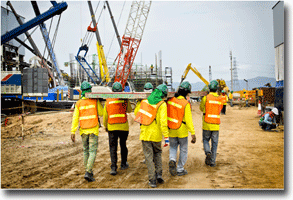Indiana Silicosis Worker's Comp Lawsuits
Information for Persons Denied Worker's Compensation for Silicosis in Indiana
Persons in Indiana who have been harmed by silicosis exposure at work may be entitled to worker's compensation. Indiana silicosis worker's comp lawsuits may be filed by persons and family members of persons who were denied worker's compensation after developing silicosis in Indiana. This page provides information about the dangers of silica dust exposure and who is eligible to file a Indiana silicosis worker's comp lawsuit.

The lung disease now known as silicosis has been acknowledged for centuries. The ancient Greeks were aware that quarry workers were susceptible to lung disease, evidenced in the writings of Hippocrates. The knowledge that lung damage could be prevented with the use of respirators has been known for almost as long, reveal the ancient records of Pliny. The history of awareness in the United States dates back to early 1900s. In 1917, the U.S. Public Health Service warned foundry workers and sandblasters of the risk of silica dust inhalation, and the 1920s and 1930s saw a deluge of silicosis lawsuits.
Silicosis is entirely preventable, yet thousands of workers in the U.S., including people in Indiana, are still affected by the condition on a regular basis. The National Institute for Occupational Safety and Health (NIOSH) estimates that at least 1.7 million workers may be exposed to respirable silica particles each year directly through their occupation. The organization also notes there are roughly 4 million agricultural workers in the United States who may potentially be exposed as well. A recent study conducted by NIOSH showed that silicosis death rates have dropped generally, but younger workers (age 15-44) have seen no decline in deaths. The exact number of cases is impossible to know for the following reasons: the symptoms of the condition are quite general, leading to under-diagnosis and misdiagnosis; workers may die from silicosis itself or from other silica-related diseases such as lung cancer and TB, as well as autoimmune disorders and chronic renal disease.
A few explanations for continued silicosis deaths have been proposed:
| Lack of proper safety equipment | Companies that do not provide adequate safety equipment can be held accountable for deaths and injuries through silicosis lawsuits. |
| Lack of enforcement of regulations | Similarly, industrial settings in which federal prevention measures are not enforced can result in silicosis lawsuits against mining companies, quarrying companies, and other companies whose workers are exposed to silica dust on the job. OSHA’s permissible exposure limit (PEL) for airborne silica crystal exposure is 〖0.1 mg/m〗^3. |
| Unsafe Permissible Exposure Level | NIOSH suggests that current occupational standards for silica exposure are inadequate to prevent the condition. A 2009 epidemiologic study from NIOSH showed that long-term exposure to respirable silica particles at OSHA’s PEL rate of 〖0.1 mg/m〗^3 can still result in chronic silicosis. NIOSH currently recommends a lower PEL of 〖0.05 mg/m〗^3. |
Silicosis Warnings
Many national and international organizations have warned of the threat of lung disease from prolonged exposure to silica dust. Silicosis warnings have been issued by the following influential organizations, among many others:
- The National Institute for Occupational Safety and Health (NIOSH)
- The Occupational Safety and Health Administration (OSHA)
- The Mine Safety and Health Administration (MSHA)
- The American Lung Association
- The Office of Occupational Health at the World Health Organization
Leading Silicosis Industries and Silica Exposure Hazards
Silica is the second most common substance on earth and is found in mineral deposits throughout the world. Silica dust may be produced with cutting, grinding, drilling, or otherwise disturbing the following materials and products:

- Soil
- Ores and associated rocks
- Sandstone
- Granite
- Flint
- Sand
- Gravel
- Slate
- Diatomaceous earth
- Concrete
- Mortar
- Plaster
- Shingles
- Crushed quartz
- Refractory materials
- Clay
- Limestone
- Tripoli
- Shale
- Quartzite
- Silica flour
- Semiprecious gems
- Glass
- Glazes
- Bricks
- Ash
- Priming putty for autos

Workers who are most at risk for silicosis are miners and sandblasters, but there are a wide range of other industries in which workers may encounter silica dust. Industries that pose a silica dust inhalation risk to workers include:
- metal mining
- mineral and stone products
- mining and quarrying
- iron and steel foundries
- pottery and structural clay products
- coal mining
- blast furnaces and steel works
- metal products
- industrial chemicals
- other manufacturing divisions
- construction
- retail store workers who handle products that produce silica dust
Diagnosis and Treatment of Silicosis Lung Disease
Because its symptoms are generic, silicosis is commonly mistaken for other ailments. The International Labour Organization asserts that the condition affects tens of millions of workers around the globe who are employed in hazardous conditions and kills thousands of people each year. No one knows exactly how many people suffer from silicosis, and the disease is thought to be wildly underdiagnosed. Diagnosis is based upon three factors: a history of silica dust exposure, a chest X-ray revealing scar tissue and/or fibritic nodules in the upper lung nodes, and the absence of another diagnosis or obvious cause. Early detection is quite uncommon as the symptoms (shortness of breath and bluish skin at the ear lobes or lips) are subtle and common to many other ailments. A pulmonologist can diagnose silicosis based on examination of a chest X-ray and confirmation of silica dust exposure. Patients may be misdiagnosed as having pulmonary edema or pneumonia.
Silicosis is considered incurable, but certain measures can be taken to slow the disease’s progression. Persons who have been diagnosed with the condition should immediately halt their exposure to silica dust and should stop smoking. Measures can be taken to relieve pain, and oxygen and steroids may be prescribed to help the patient breathe. Immunosuppressive drugs may help to slow the development of inflammation temporary. Infections that develop in the lungs should be treated. Finally, a patient’s life may be prolonged with a lung transplant.
Indiana Silicosis Worker's Comp Lawyers Help Workers and their Families in Indiana

Our attorneys handling silicosis lawsuits in Indiana for workers who have suffered from silicosis lung disease have expertise representing individuals against large, powerful companies. Leaving no stone unturned as they thoroughly prepare your case for trial, our Indiana silicosis attorneys will stand behind your family and fight on your behalf to assure you get the compensation you deserve. If you or a loved one developed lung disease as a result of silica exposure on the job in Indiana, a member of our Indiana silicosis lawyer team will be happy to provide you with a free case analysis.
Indiana Silicosis Worker's Comp Lawsuits for Lung Disease, Lung Cancer, and TB
Men and the family members of men in Indiana who have suffered from silicosis lung disease and related diseases such as lung cancer and tuberculosis may have legal grounds to file a Indiana silicosis lawsuit. Our attorneys provide legal representation for Indiana silicosis lawsuits on a contingency basis, meaning there are never any fees for our legal services unless we win compensation on your behalf.

 OnderLaw, LLC -
OnderLaw, LLC -